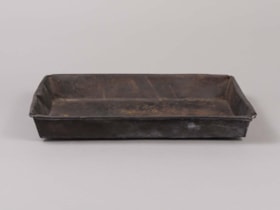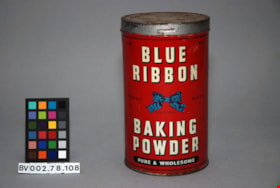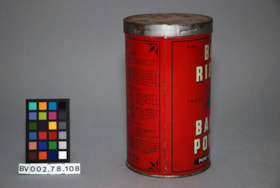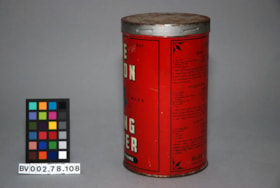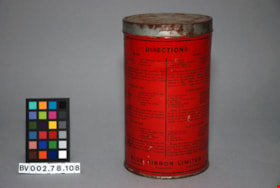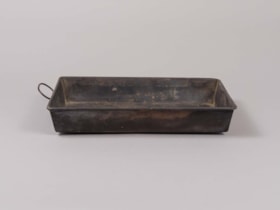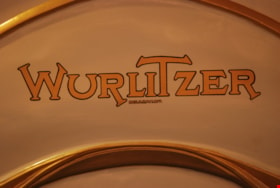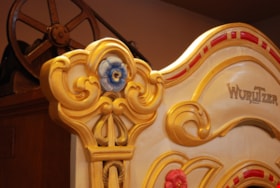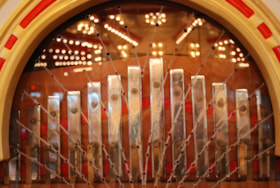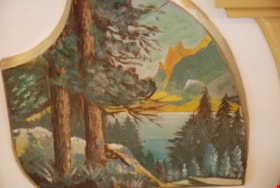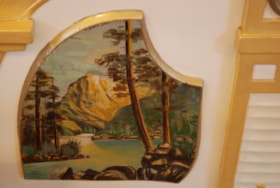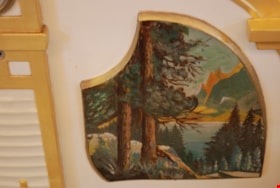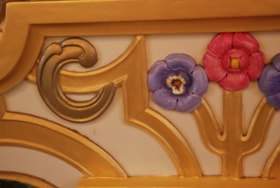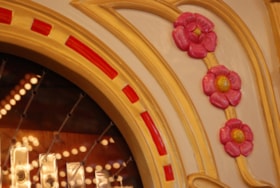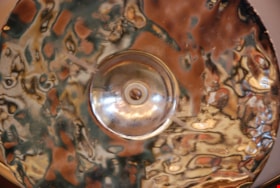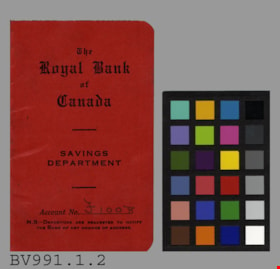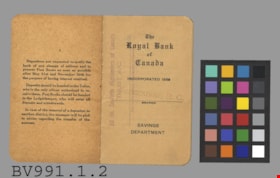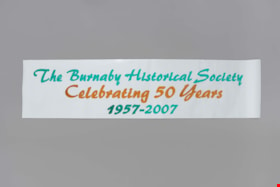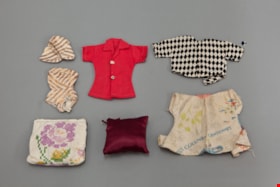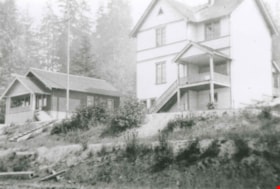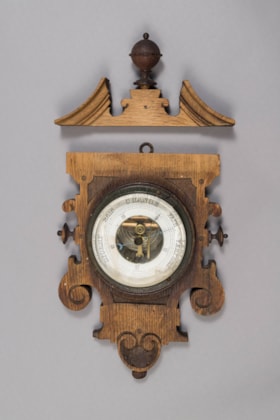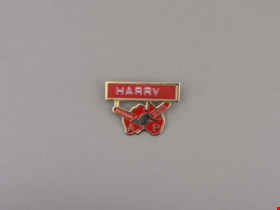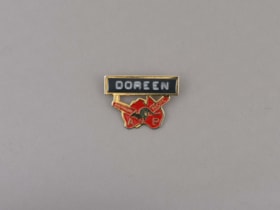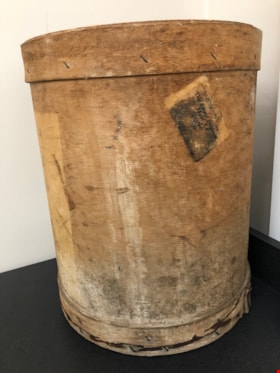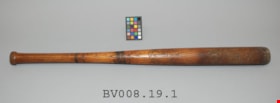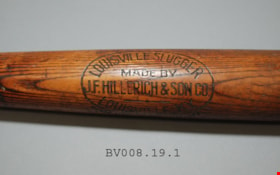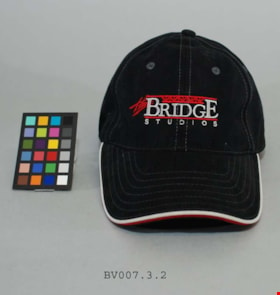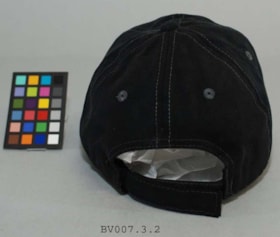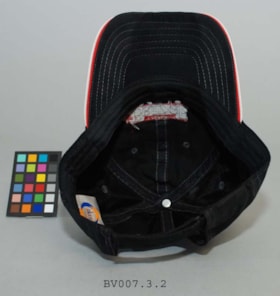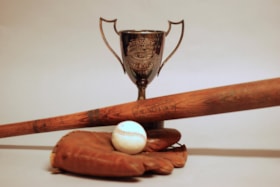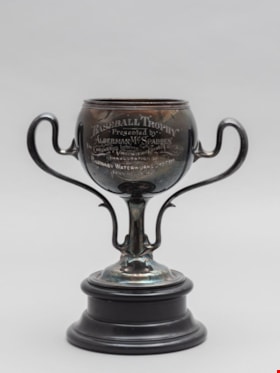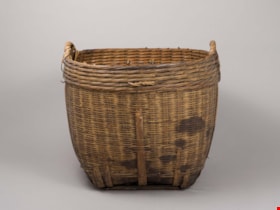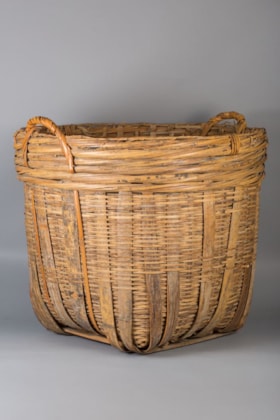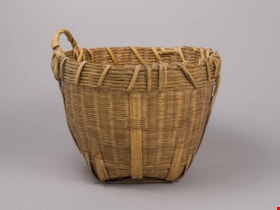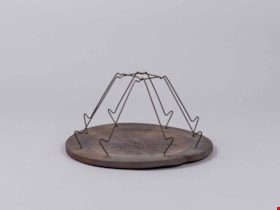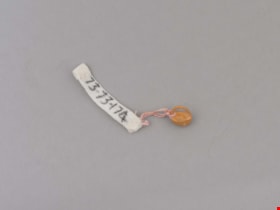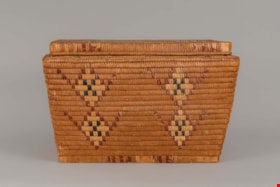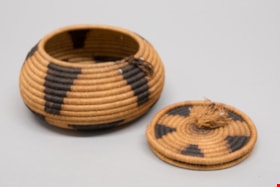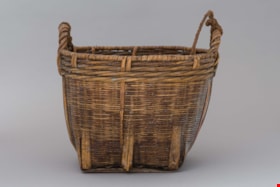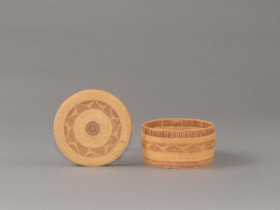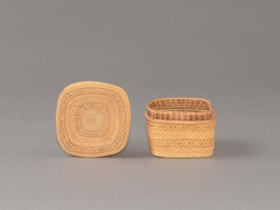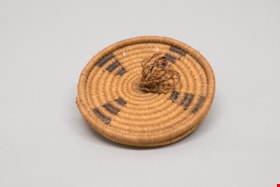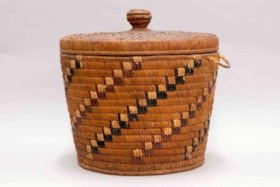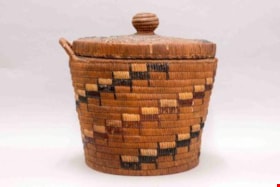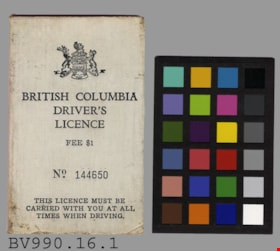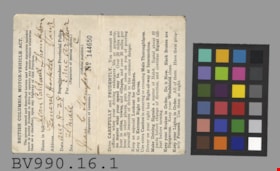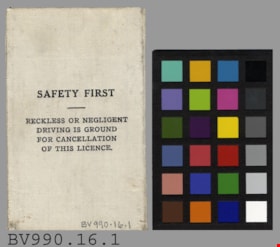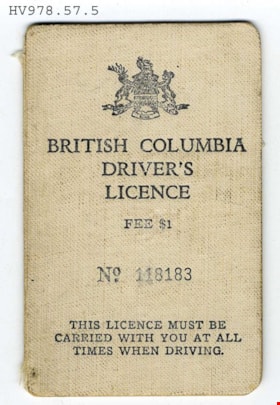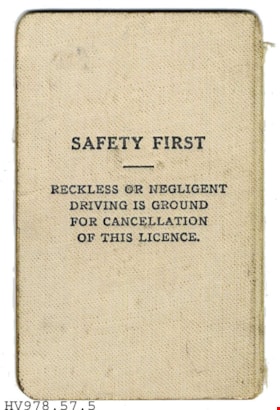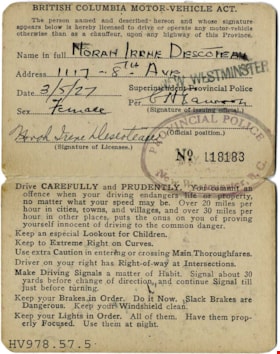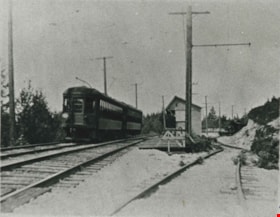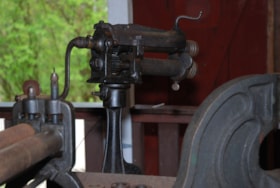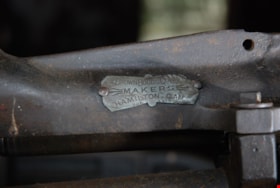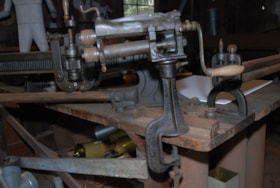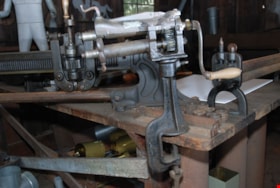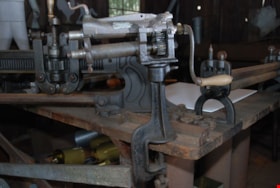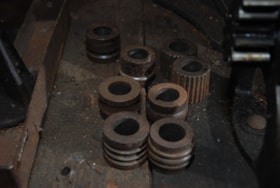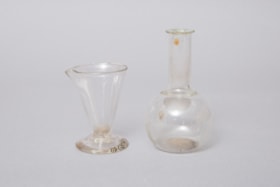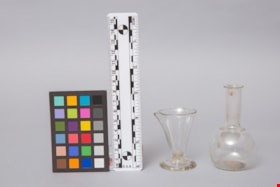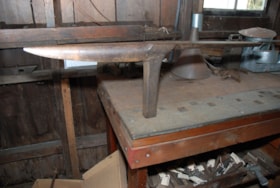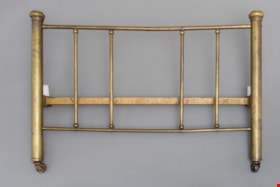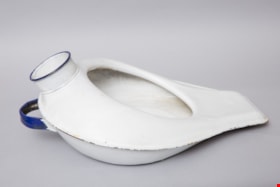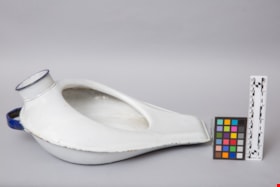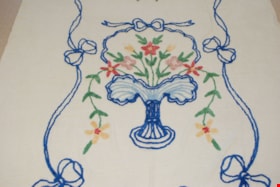Narrow Results By
Subject
- Adornment 83
- Adornment - Jewelry 4
- Adornment - Lapel Pins 83
- Advertising Medium 92
- Advertising Medium - Business Cards 17
- Advertising Medium - Flyer 34
- Advertising Medium - Poster 2
- Advertising Medium - Signs and Signboards 38
- Agricultural Tools and Equipment 5
- Agricultural Tools and Equipment - Cultivators 1
- Agricultural Tools and Equipment - Gardening Equipment 2
- Agriculture 3
Creator
- Albert F. Arnold 1
- Albert F. Arnold McCarter & Nairne 1
- Alphonse J. Toebaert 1
- Bernard R. Hill 1
- Bowman and Cullerne 2
- Bowman & Cullerne 5
- British Columbia Hydro and Power Authority 1
- Burnaby Monumental Works 1
- Burnaby Parks and Recreation Commission 1
- Burnaby Village Museum 9
- Buzza, Joy 4
- Cecil Croker Fox 1
Person / Organization
- A & H Plastering and Stucco 1
- Aikenhead, May 7
- Air Raid Precautions (A.R.P.) 30
- Allen, James Charles 1
- Alpha Secondary School 4
- Army, Navy and Air Force Veterans in Canada, Pompier Unit #314 1
- Bailey, Joan 8
- Barnet Lumber Company 2
- Bateman, Catherine "Cassie" Dale 1
- Bateman, Edwin W. 5
- Bateman Family 9
- Bateman, Mary Dale 2
baking pan
https://search.heritageburnaby.ca/link/museumartifact24593
- Repository
- Burnaby Village Museum
- Accession Code
- HV975.5.1089
- Description
- Baking tin
- Object History
- Contents of Chinese Herbalist Store "Way Sang Yuen Wat Kee & Co.", Victoria B.C.
Images
baking powder canister
https://search.heritageburnaby.ca/link/museumartifact76725
- Repository
- Burnaby Village Museum
- Accession Code
- BV002.78.108
- Description
- canister, metal, round with lid; red, blue, white, black; picture of blue bow; surface scratches, rust; some powder residue inside; paper remnants around top edge; with lid, has metal deterioration on top
- Object History
- Donor purchased objects from various collectors and antique retailers.
- Marks/Labels
- "3 Lbs. Net" "Blue Ribbon" "Trade Mark""Registered" "Baking Powder" "Pure & Wholesome"; on back, "Directions"; three recipes follow, repeat in French; "Blue Ribbon Limited" "Winnipeg Toronto Vancouver"
- Maker
- Blue Ribbon Limited
- Country Made
- Canada
- Subjects
- Product Packaging
- Container
- Geographic Access
- Vancouver
Images
baking tin
https://search.heritageburnaby.ca/link/museumartifact24594
- Repository
- Burnaby Village Museum
- Accession Code
- HV975.5.1090
- Description
- Baking tin; one handle is missing
- Object History
- Contents of Chinese Herbalist Store "Way Sang Yuen Wat Kee & Co.", Victoria B.C.
Images
band organ
https://search.heritageburnaby.ca/link/museumartifact33964
- Repository
- Burnaby Village Museum
- Accession Code
- BV991.21.1
- Description
- This is a Wurlitzer Military Band Organ, Style 146B. Built by the Rudolph Wurlitzer Company, ca 1925. The organ is supposed to recreate the sound of a 20-piece military band, with percussion instruments that include bass drum, snare drums, cymbals, and xylophones, as well as pipes to reproduce the sounds of trumpets, trombones, flutes, and violins. This band organ is operated by paper rolls based on Wurlitzer's unique, 46 note roll scale, "Style 150". Our Model 146B has duplex roll frames, allowing continuous playing, one roll rewinds as the other is playing. An electric motor mounted on the top uses a belt to drive a crankshaft that powers both the air bellows that feed the various music pipes as well as the roll mechanism. The band organ was originally intended to be used with a carousel out of doors. A perferated sheet of plexie glass has been placed over the front opening to reduce the volume of the instrument inside the carousel building. Outside Visible Snare Drum on proper right Bass Drum with cymbal on proper left Inside 16 Octave Violin Pipes 3 Wooden Trombones 3 Octave Stopped Bass Pipes 15 Wooden Trumpets 15 Stopped Flute Pipes 16 Violin Pipes 9 Open Pipes Bottom 3 Open Bass Pipes 9 Stopped Accompaniment Pipes 16 Stopped Melody Pipes Bells 16 Bell Bars, playing form the musical roll.
- Object History
- The band organ was purchased and restored by the Friends of the Carousel to replace the original organ that had been sold before the carousel was acquired for the Burnaby Village Museum. The Friends of the Carousel bought this machine from a collector in Spokane, Washington. He had obtained it from a closed down travelling carnival company in Reno, Nevada. They had used it with a carousel in the American mid-west.
- Marks/Labels
- "Wurlitzer", painted in gold on front of organ
- Country Made
- United States of America
- Province Made
- New York
- Site/City Made
- North Tonawanda
Images
bankbook
https://search.heritageburnaby.ca/link/museumartifact4555
- Repository
- Burnaby Village Museum
- Accession Code
- BV991.1.2
- Description
- Royal Bank of Canada - Bank Book -- [192-]. Red covered bankbook from the Royal Bank of Canada Savings Department. The account number written on the front is "F1008". Stamped on the first page of the book is "1st Bn. Seaforth Highlanders of Canada/ TRUST A/C" and "Vancouver , B.C.". All the pages of the bank book are filled starting at March 1920, ending at December 1920. The bank book measures 7.5cm x 12cm.
- Colour
- Red
- Subjects
- Documentary Artifacts
Images
banner
https://search.heritageburnaby.ca/link/museumartifact89592
- Repository
- Burnaby Village Museum
- Accession Code
- BV017.32.80
- Description
- banner; glossy white paper with green and purple inked lettering and black ink signatures; text in green reads: "END OF THE LINE PARTY" above text in purple reading: "THANK YOU VOLUNTEERS OF THE 1223"; signatures of party attendees/volunteers(?) in black ink; dated on back in black ink: "FEB. 23, 2008".
- Category
- 08. Communication Artifacts
- Classification
- Documentary Artifacts - - Graphic Documents
- Object Term
- Banner
- Measurements
- L: 189.0 cm W: 45.7 cm
- Subjects
- Documentary Artifacts
Images
banner
https://search.heritageburnaby.ca/link/museumartifact89593
- Repository
- Burnaby Village Museum
- Accession Code
- BV017.32.81
- Description
- banner; glossy white paper with green and tan inked lettering; text in green reads: "The Burnaby Historical Society" and "1957 - 2007" surrounding text in brown reading: "Celebrating 50 Years"; oval-shaped gold foil adhesive label on back has text in black reading: "604.461.1711 / Party / Tailors / www.partytailors.com".
- Category
- 08. Communication Artifacts
- Classification
- Documentary Artifacts - - Graphic Documents
- Object Term
- Banner
- Measurements
- L: 190.0 cm W: 45.7 cm
- Subjects
- Documentary Artifacts
Images
Barbie clothes and accessories.
https://search.heritageburnaby.ca/link/museumartifact82623
- Repository
- Burnaby Village Museum
- Accession Code
- BV012.14.159
- Description
- Handmade Barbie clothes and various accessories. Large box contains: a)tray containing various Barbie clothes on hangers b)tray containing various Barbie clothes on hangers c)tray containing various Barbie clothes and wigs on plastic stand d)plastic box containing various Barbie pants and skirts e)plastic box containing various Barbie accessories and baby doll f)plastic box containing various Barbie accessories, including metal tin containing shoes and paper box g)blue floral pattern tin containing Barbie kitchen accessories h)green floral pattern tin containing two small pillows
- Object History
- From the Yanko family home in Burnaby. Barbie clothes made by Lillian Yanko, mother. Barbies belonged to daughters Charmaine and Rhonda Yanko. Annie D. Basiuk (later Yanko) was born on February 25, 1902 in Sheho, Saskatchewan (formerly Sheho, North West Territories). Daniel "Dan" Yanko was born in Kobilnicha, Ukraine in 1887 and immigrated to Canada in May or June of 1905. Daniel Yanko married Annie D. Basiuk and had thirteen children together. Their son, John Ivan Yanko was born on the family farm, near Kelliher, Saskatchewan, on June 27, 1923. In grade six, John was pulled out of school to help support the family. Eugenia “Jenny” Haresomovych (later Carman) was born August 8, 1904 in Galecia, Austria. She came to Canada in 1928, when her parents sent her to live with the Austrian consular in Halifax. A year later, she was in The Pas with Albert Edward Carman, with whom she would have three children. Their daughter, Leida Doria "Lillian Doris" Carman was born in The Pas, Manitoba March 24, 1929. Eugenia “Jenny” (Haresomovych) Carman later re-married Joseph Nagy who was born in Hungary in October 3, 1900. Jenny, Joseph and the children moved to Nelson, British Columbia, where Joseph worked for the Canadian Pacific Railway. At the age of twenty, John Yanko met his future wife Lillian Doris Carman while visiting relatives in Burnaby. Lillian received a rail pass because of her dad’s employment with the CPR and at fourteen had gone to visit her Godmother in Burnaby. John Ivan Yanko and Leida Doria "Lillian Doris" Carman were married October 16, 1948 in Nelson, British Columbia and moved into the basement of John’s sister’s house on Union Street. Lillian began working at the downtown Woodward’s store as a cashier in 1948. In 1950, the young couple bought property at 7385 (later renumbered 7391) Broadway in Burnaby and began constructing a house as they could afford it. Knowing she’d be let go if she was pregnant, when Lillian was expecting her first child, Jenny sewed her several versions of the same outfit; they all used the same material, but each was a little bit larger than the last to accommodate her expanding girth. Rhonda, born in 1953 and Charmaine, born in 1955, grew up in the Broadway home. They attended school at Sperling Elementary, and later at Burnaby North high school. Lillian left her job to be a stay-at-home mom when Rhonda was born, but that changed in 1963 when John and Charmaine were in a car accident that left John temporarily unable to work. Joseph Nagy died April 20, 1962; his wife Eugenia “Jenny” (Haresomovych) (Carman) Nagy passed away August 14, 1985. Daniel "Dan" Yanko died in 1976; his wife Annie D. (Basiuk) Yanko died in 1997. John Yanko later returned to work, establishing his own tile setting business and working until age eighty-two. John and Lillian lived out the rest of their married lives on the Broadway property. John Ivan Yanko passed away in 2010; his wife Leida Doria "Lillian Doris" Carman (Carman) Yanko passed away in 2011.
- Subjects
- Toys
- Names
- Yanko Family
- Bayntun, Charmaine "Sherrie" Yanko
- Yanko, Leida Doria "Lillian Doris" Carman
- Yanko, Rhonda
Images
Barnet Lumber Company House
https://search.heritageburnaby.ca/link/landmark662
- Repository
- Burnaby Heritage Planning
- Description
- Residential building.
- Associated Dates
- 1925
- Street View URL
- Google Maps Street View
- Repository
- Burnaby Heritage Planning
- Geographic Access
- Texaco Drive
- Associated Dates
- 1925
- Description
- Residential building.
- Heritage Value
- This house is one of two surviving houses built as a “Model Home” for the manager of the Barnet Lumber Company, which was the successor to the North Pacific Lumber Company. It was used as a combined home and office. It was constructed with framing lumber and millwork sawn at the mill. Typical of the Craftsman style, the house has a front gabled roof with triangular eave brackets. It has been altered with the addition of asbestos shingles over the original siding, but retains its form, scale and massing. This house was designed by the firm of Townley & Matheson. The partnership of Fred Laughton Townley (1887-1966) and Robert Michael Matheson began in 1919, and the firm left a rich legacy of sophisticated work, including schools, commercial structures, many fine residences and the landmark Vancouver City Hall.
- Historic Neighbourhood
- Barnet (Historic Neighbourhood)
- Planning Study Area
- Burnaby Mountain Area
- Architect
- Townley & Matheson
- Area
- 2225.77
- Contributing Resource
- Building
- Ownership
- Public (local)
- Street Address
- 8007 Texaco Drive
- Street View URL
- Google Maps Street View
Images
Barnet Lumber Company House
https://search.heritageburnaby.ca/link/landmark663
- Repository
- Burnaby Heritage Planning
- Description
- Residential building.
- Associated Dates
- 1925
- Street View URL
- Google Maps Street View
- Repository
- Burnaby Heritage Planning
- Geographic Access
- Texaco Drive
- Associated Dates
- 1925
- Description
- Residential building.
- Heritage Value
- This house is one of two surviving houses built as a “Model Home” for one of the assistant managers of the Barnet Lumber Company, using framing lumber and millwork sawn at the mill. This house was also designed by the firm of Townley & Matheson. The house was raised and renovated in 1997, resulting in alterations such as new dormers and elongated porch piers.
- Historic Neighbourhood
- Barnet (Historic Neighbourhood)
- Planning Study Area
- Burnaby Mountain Area
- Architect
- Townley & Matheson
- Contributing Resource
- Building
- Ownership
- Private
- Street Address
- 8039 Texaco Drive
- Street View URL
- Google Maps Street View
Images
Barnet Mountain Park Dedication
https://search.heritageburnaby.ca/link/landmark686
- Repository
- Burnaby Heritage Planning
- Associated Dates
- 1942
- Heritage Value
- For years, the idea of creating a park on Burnaby Mountain was favoured by people in Burnaby. In 1930, the Municipal Engineer submitted a report recommending that the city acquire land in the area with a view towards formally dedicating the space for public use. In 1942, Commissioner Richard Bolton enacted Bylaw 1772 which officially dedicated the mountain as public park.
- Historic Neighbourhood
- Barnet (Historic Neighbourhood)
- Planning Study Area
- Burnaby Mountain Area
Images
Barnet Neighbourhood
https://search.heritageburnaby.ca/link/landmark681
- Repository
- Burnaby Heritage Planning
- Associated Dates
- 1925-1954
- Heritage Value
- In 1925, the mill at Barnet was under new ownership and was known as the Barnet Lumber Company. It was one of the most successful local employers in Burnaby until the 1930s, when the economic crisis of the Great Depression resulted in a strike at the mill. The City of Burnaby eventually assumed control of the site - including all of the homes - when the company failed to pay its taxes. The City then dismantled the mill and resold the property in two parts - the eastern section would become the Kapoor sawmill and the western portion, the McColl-Frontenac Oil Company.
- Historic Neighbourhood
- Barnet (Historic Neighbourhood)
- Planning Study Area
- Burnaby Mountain Area
Images
Barnet Neighbourhood
https://search.heritageburnaby.ca/link/landmark716
- Repository
- Burnaby Heritage Planning
- Associated Dates
- 1889-1904
- Heritage Value
- The North Pacific Lumber Company in Barnet was one of Burnaby's first industrial developments and one of the largest in the British Empire. Partners James MacLaren and Frank Ross built the mill in 1889 (activated in 1899) as a requirement for obtaining 84,000 acres of timber rights in northern BC. Due to the mill's isolation, the firm built homes for its employees with families and bunkhouses for the bachelors which separated Caucasian workers from Chinese and Sikh workers. Barnet became a distinct company town with its own general store, school, post office, community hall and telephone exchange.
- Historic Neighbourhood
- Barnet (Historic Neighbourhood)
- Planning Study Area
- Burnaby Mountain Area
Images
Barnet Neighbourhood
https://search.heritageburnaby.ca/link/landmark747
- Repository
- Burnaby Heritage Planning
- Associated Dates
- 1905-1924
- Heritage Value
- The original Barnet mill burned down in 1909 after a dramatic explosion in the boiler house. The company rebuilt a new plant, considered a model of mill construction. The company's timber was towed down the Pacific in huge rafts containing about 400,000 to 500,000 board feet. Mill capacity during a 10-hour day was 150,000 board feet with an amazing annual output of 50 million feet.
- Historic Neighbourhood
- Barnet (Historic Neighbourhood)
- Planning Study Area
- Burnaby Mountain Area
Images
Barnet School
https://search.heritageburnaby.ca/link/landmark719
- Repository
- Burnaby Heritage Planning
- Geographic Access
- Barnet Road
- Associated Dates
- 1899
- Heritage Value
- When the Barnet Mill began operations in 1899, the mill authorities opened a small school to accommodate the children of employees. The school was located in a remodelled harness-room beside the mill and Miss Phoebe Spragge was the first teacher at a salary of $40.00 per month. By 1907, the school had been moved to a purpose-built building where it remained in operation until the early 1950s.
- Historic Neighbourhood
- Barnet (Historic Neighbourhood)
- Planning Study Area
- Burnaby Mountain Area
- Street Address
- 7820 Barnet Road
Images
barometer
https://search.heritageburnaby.ca/link/museumartifact90178
- Repository
- Burnaby Village Museum
- Accession Code
- BV019.8.16
- Description
- barometer; aneroid barometer secured to a carved wood plaque; barometer has a calibrated dial to indicate air pressure; text on dial reads: "VERY DRY", "FAIR", "CHANGE", "RAIN", and "STORMY"; flat metal loop at top of wood plaque for hanging. Dark stained carved wood decorative scroll with finial; has detached from base plaque.
- Object History
- Object used in the Love Farmhouse, currently on site at Burnaby Village Museum.
- Geographic Access
- Cumberland Street
- Street Address
- 7651 Cumberland Street
- Historic Neighbourhood
- East Burnaby (Historic Neighbourhood)
- Planning Study Area
- Cariboo-Armstrong Area
Images
bar pin
https://search.heritageburnaby.ca/link/museumartifact91233
- Repository
- Burnaby Village Museum
- Accession Code
- BV021.23.1
- Description
- Lapel pin name badge from Australian Pacific touring company. The pin is gold coloured with a horizontal bar for a name label to be affixed. Below the bar is the shape of Australia outlined in gold, filled in with red. In the centre is a gold coloured kangaroo witht he company name on either side.
- The name portion has been filled in with a red embossed label with the name "HARRY".
- Object History
- Possible that the pin was made for guests of Australian Pacific tours.
- Category
- 03. Personal Artifacts
- Classification
- Clothing - - Clothing Accessories
- Object Term
- Pin, Bar
- Marks/Labels
- "HARRY"
- "AUSTRALIAN PACIFIC"
- "A P"
- Maker
- Evan Evans
- Subjects
- Travel
Images
bar pin
https://search.heritageburnaby.ca/link/museumartifact91234
- Repository
- Burnaby Village Museum
- Accession Code
- BV021.23.2
- Description
- Lapel pin name badge from Australian Pacific touring company. The pin is gold coloured with a horizontal bar for a name label to be affixed. Below the bar is the shape of Australia outlined in gold, filled in with red. In the centre is a gold coloured kangaroo witht he company name on either side.
- The name portion has been filled in with a black embossed label with the name "DOREEN".
- Object History
- Possible that the pin was made for guests of Australian Pacific tours.
- Category
- 03. Personal Artifacts
- Classification
- Clothing - - Clothing Accessories
- Object Term
- Pin, Bar
- Marks/Labels
- "HARRY"
- "AUSTRALIAN PACIFIC"
- "A P"
- Maker
- Evan Evans
- Subjects
- Travel
Images
Barrel
https://search.heritageburnaby.ca/link/museumartifact90555
- Repository
- Burnaby Village Museum
- Accession Code
- BV020.22.1
- Description
- Cylindrical veneer mushroom spawning barrel. The wood has been shaped to make the barrel. There is a base and rim around the top and bottom of the barrel, stapled to hold it together. There are a number of stains, discolourations, ink, and evidence of past mold. There is also a lid with a metal ring afixed to it. The lid has the name "Stiglish" handwritten with a circled number "2". In black ink, a stamp reads: Fraser Valley Mush Grow.Co-op Assn.265 E. Georgia St. Vancouver, B.C. Canada"
- Object History
- Used on the Stiglish family mushroom farm
- Category
- 04.Tools & Equipment for Materials
- Classification
- Agricultural T&E - - Cultivation Equipment
- Object Term
- Barrel
- Marks/Labels
- Railway Express Agency Incorporated / Printed in U. / This Export Shipment Must Be Routed Via
- Colour
- Brown
- Gray
- Black
- Measurements
- 14" in diameter and 17" high
- Historic Neighbourhood
- Burquitlam (Historic Neighbourhood)
Images
baseball bat
https://search.heritageburnaby.ca/link/museumartifact80101
- Repository
- Burnaby Village Museum
- Accession Code
- BV008.19.1
- Description
- This is a wood baseball bat, 83 cm long, 4 cm diameter at thinest part of handle, 7 cm diameter at top end of bat. The bat is stained a mid brown colour. The bottom of the handle expands into a ring but two opposite faces are chipped flat. The wood grain at the top end of the bat has begun to open up. "LOUISVILLE SLUGGER / MADE BY / J. F. HILLERICH & SON CO. / LOUISVILLE, KY" stamped and burned inside of an oval at the mid point on the bat. "TRADE MARK REG. U.S. PAT. OFF", stamped and burned under the oval logo at the mid point on the bat.
- Object History
- These items were used by the Thomson family in the Kerrisdale area of Vancouver.
- Subjects
- Sports
- Sports - Baseball
- Sports Equipment
Images
baseball cap
https://search.heritageburnaby.ca/link/museumartifact79037
- Repository
- Burnaby Village Museum
- Accession Code
- BV007.3.2
- Description
- Give-away baseball cap from the Bridge Film Studio in Burnaby. The cap is black with red trim, "knp" makers logo. Made in China, 100% polyester.
- Object History
- Obtained from the Bridge Studio Burnaby circa 2006. The Bridge Studios was built in 1987 on 15 acres of land that was formerly part of the Dominion Bridge bridge-building plant. From 1930 until the mid 1970s, Dominion Bridge constructed steel structures ranging from portions of the Golden Gate and Lions Gate Bridges to holding tanks for pulp mills. Several of the Dominion Bridge buildings were re-used by the studio, including the Cafeteria Building, the Boiler House, and the Compressor Building. In the mid-1970s filming began on a temporary basis in unused portions of the plant. In 1987, after lobby efforts by local film industry unions, guilds, and suppliers, the Government of British Columbia agreed to invest in renovating the site to create a permanent studio facility in order to ensure that BC had a stable base of operations for film production. The Bridge Studios, the first dedicated studio facility in Vancouver, opened for business in 1987 with television series "MacGyver" and the feature film "Stakeout" among the first productions to have used the facility.
- Subjects
- Clothing
- Clothing - Headwear
- Names
- Bridge Studios
Images
baseball trophy
https://search.heritageburnaby.ca/link/museumartifact12472
- Repository
- Burnaby Village Museum
- Accession Code
- BV985.4071.1
- Description
- Trophy, silver cup with handle either side, mounted on polished round wooden base; on cup front, "BURNABY SCHOOL LEAGUE BASEBALL TROPHY" "PRESENTED FOR PERPETUAL COMPETITION BY ALFRED W. MCLEOD LTD." "NEW WESTMINSTER AND VANCOUVER, B.C." "1925"; A strip of polished metal is mounted around the circumference of the wood base. I has the names of the trophy recipients engraved on it. It is divided into five sections by engraved lines, each headed "WINNER"; centre section "1925 GILMORE AVENUE" "1926 NELSON AVENUE" "1927 NELSON AVENUE"; other sections are blank ; The cup and strip are tarnished
Images
baseball trophy
https://search.heritageburnaby.ca/link/museumartifact26143
- Repository
- Burnaby Village Museum
- Accession Code
- HV975.147.2
- Description
- Trophy, silver cup, handle either side, mounted on round wooden base; on front "BASEBALL TROPHY" "Presented by" "ALDERMAN MCSPADDEN" "For Competition between Vancouver and Greater Vancouver INAUGURATION OF BURNABY WATERWORKS SYSTEM JULY 16TH 1912"; on back, left "VANCOUVER" "ALDERMAN W.S.CAMERON", and nine more aldermen, "SIX RUNS"; right side, "GREATER VANCOUVER" "COUNCILLOR F.M.BRITTON, BURNABY; then three more Burnaby councillors: "COUNCILLOR P.W. FAUVEL", "COUNCILLOR A. MacDONALD", "COUNCILLOR W.H. MADILL", "COUNCILLOR C.S. CAMPBELL", and "COUNCILLOR ELLIOT"; then "REEVE R.S.HARVEY, POINT GREY", and two Point Grey councillors, "TWENTY RUNS"; tarnished; '188' in base.
- Category
- 09. Recreational Artifacts
- Classification
- Personal Symbols - - Achievement Symbols
Images
basket
https://search.heritageburnaby.ca/link/museumartifact1168
- Repository
- Burnaby Village Museum
- Accession Code
- HV971.26.3
- Description
- Wicker basket
Images
basket
https://search.heritageburnaby.ca/link/museumartifact2720
- Repository
- Burnaby Village Museum
- Accession Code
- HV971.171.1
- Description
- Chinese basket
- Category
- 04.Tools & Equipment for Materials
- Classification
- Food Processing & Preparation T&E - - Food Storage Equipment
Images
basket
https://search.heritageburnaby.ca/link/museumartifact17681
- Repository
- Burnaby Village Museum
- Accession Code
- HV978.2.13
- Description
- Nut-shaped, coiled cedar root basket with cedar root foundation and watch-spring base and lid construction. Hinged lid is attached with leather ties. Covered in beading, where in the decorative elements are laid flat on surface, rather than folded into cedar root stitches as is done with imbrication. Designs are in red and black dyed cherry bark. Interior Salish: Nlaka’pamux
- Object History
- Nut-shaped baskets are identified as one of the oldest types by Haeberlin and Teit (1928: 202-3). They were used for storing berries and were also common work baskets for women, used to hold small tools – awls, thread, shells, trinkets and other odds and ends (202).
- Country Made
- Canada
- Province Made
- British Columbia
- Culture
- Nlaka'pamux
Images
Documents
basket
https://search.heritageburnaby.ca/link/museumartifact24644
- Repository
- Burnaby Village Museum
- Accession Code
- HV975.5.1141
- Description
- Bamboo basket with carrying handles
- Object History
- Contents of Chinese Herbalist Store "Way Sang Yuen Wat Kee & Co.", Victoria B.C.
Images
basket
https://search.heritageburnaby.ca/link/museumartifact24646
- Repository
- Burnaby Village Museum
- Accession Code
- HV975.5.1143
- Description
- Fruit basket; wood slats, round bottom
- Object History
- Contents of Chinese Herbalist Store "Way Sang Yuen Wat Kee & Co.", Victoria B.C.
Images
basket
https://search.heritageburnaby.ca/link/museumartifact27529
- Repository
- Burnaby Village Museum
- Accession Code
- HV974.119.3
- Description
- Rectangular coiled cedar root basket with cedar slat foundation, lid has parallel slat construction and is covered with beaded designs edged by imbrication in canary grass. Basket has a flat lid that is hinged to body with leather ties. A mistake was made in how the design was applied to one end of this basket. This is not common as many weavers would correct this mistake. Completely imbricated walls, beaded design on lid. Coast Salish: Sḵwx̱wú7mesh?
- Object History
- The donor reported that the baskets were traded in the early 1920s for clothes by the donor's mother, who lived in North Vancouver. Her mother told her the "Capilano Indians" used to go door to door with their baskets in North Vancouver.
- Diamonds are considered a star pattern and are common to Sḵwx̱wú7mesh and Nlaka’pamux basketry. The main design resembles a ladder or fence and is uncommon.
- Country Made
- Canada
- Province Made
- British Columbia
- Culture
- Sḵwx̱wú7mesh
Images
Documents
basket
https://search.heritageburnaby.ca/link/museumartifact30015
- Repository
- Burnaby Village Museum
- Accession Code
- HV973.73.174
- Description
- Cherry pit basket
Images
basket
https://search.heritageburnaby.ca/link/museumartifact30051
- Repository
- Burnaby Village Museum
- Accession Code
- HV973.79.1
- Description
- Rectangular coiled cedar root basket with cedar slat foundation. Parallel slat base and lid. Walls of basket flare slightly towards the rim. Basket has a conoid lid – one that fits over top of a flange on the rim of the basket. Rim is inset. Sets of triangular shaped stitches attach base to walls. Base of basket is protected by a foot, one slat high. Grass used for imbricated designs has a flat appearance typical of cattail grass. Black dyed and red cherry bark used for other design elements. Handles missing.
- Object History
- Design variant is uncommon. This may be a zoomorphic design possibly representing an animal head or flying bird.
- Country Made
- Canada
- Province Made
- British Columbia
- School/Style
- Coast Salish
Images
Documents
basket
https://search.heritageburnaby.ca/link/museumartifact50308
- Repository
- Burnaby Village Museum
- Accession Code
- BV006.24.5
- Description
- The basket is round with a lid and has a geometric design in black. Made using the coiled method.
- Object History
- Resembles California and Southwestern style baskets made of willow, dye and grass.
- Country Made
- United States of America
- Province Made
- California
Images
Documents
basket
https://search.heritageburnaby.ca/link/museumartifact80185
- Repository
- Burnaby Village Museum
- Accession Code
- BV006.34.2
- Description
- Chinese small, woven basket. For vending fruits and vegetables. It was given by the vender to his customers. It is a brown colour with loop handles opposite each other there is a string with a knot in the middle running from one loop to the other loop. The bottom of the basket is roughly square, becoming more round as it rises. Top is 24.5 cm by 23.5 cm. and the bottom is 14 cm square.
- Object History
- This basket was a shopping basket for cutsomers of Chinese Canadian food peddlers. The donor indicated that the peddlers sold fruit and vegetables in summer and fish in winter. It was meant to be a convenience to shoppers when she came outside to select produce.
- Category
- 04.Tools & Equipment for Materials
- Classification
- Container
- Object Term
- Basket
- Subjects
- Persons - Chinese Canadians
Images
basket
https://search.heritageburnaby.ca/link/museumartifact84019
- Repository
- Burnaby Village Museum
- Accession Code
- BV014.9.1
- Description
- This basket is woven using the wrapped twining method and is made of swamp grass. The designs were made using aniline dyes and are badly faded; original colours still visible on the inside of lid and basket. The weave on this basket is very finely done. The basket and lid are decorated with bird motifs. Originally birds were yellow on a purple background. The lid has a drop edge that fits over a lip around the top edge of the basket. It is decorated in concentric circles with a dark spot in the centre. The spot includes black as well as the wine colour. The outside is faded to a light brown colour. Nuu-chah-nulth
- Object History
- The basket was acquired in Victoria in the 1930s before the family moved to Vancouver.
- Country Made
- Canada
- Province Made
- British Columbia
- Culture
- Nuu-Chah-Nulth
Images
Documents
basket
https://search.heritageburnaby.ca/link/museumartifact84020
- Repository
- Burnaby Village Museum
- Accession Code
- BV014.9.2
- Description
- Basket with red cedar bark base and warps and swamp grass wefts. The base is done in checker weave, while the walls and lid are done using wrapped twining. The base of the basket is secured with two strand twining and then the warps were split and smaller rows of two strand twining follow. The edge of the base is distinguished by one row of three strand twining, which creates a noticeable break in the pattern, before the wrapped twining begins for the walls. Designs, consisting of horizontal stripes, were made using analine dyes, which are extremely light sensitive. Colours are preserved on inside of basket, where light exposure has been much lower. Originally red and black stripes. Nuu-chah-nulth
- Object History
- The basket was acquired in Victoria in the 1930s before the family moved to Vancouver.
- Country Made
- Canada
- Province Made
- British Columbia
- Culture
- Nuu-Chah-Nulth
Images
Documents
basket lid
https://search.heritageburnaby.ca/link/museumartifact50309
- Repository
- Burnaby Village Museum
- Accession Code
- BV006.24.6
- Description
- The basket is round with a lid and has a geometric design in black. Made using the coiled method.
- Object History
- Resembles California and Southwestern style baskets made of willow, dye and grass.
Images
Documents
basket with lid
https://search.heritageburnaby.ca/link/museumartifact87630
- Repository
- Burnaby Village Museum
- Accession Code
- BV017.11.3
- Description
- basket with lid; First Nations basket with lid; The basket is round, with two handles opposite each other. The handles are wrapped twine. The wrapping is missing from one handle. The lid has a knob handle in the centre. Basket and lid are decorated with a dark and light spiraling pattern. Had been used for storing knitting.
- Object History
- The basket was acquired by the donor's grandparents, Matilda and Robert William Handel, when they were living in North Vancouver. They were made by one of the local First Nations weavers, name unknown.
- Measurements
- Approx. H: 32 cm Dia.: 34 cm
- Culture
- ʷməθkʷəy̓əm (Musqueam)
Images
Documents
basket with lid
https://search.heritageburnaby.ca/link/museumartifact87633
- Repository
- Burnaby Village Museum
- Accession Code
- BV017.11.4
- Description
- basket with lid; First Nations basket with lid; The basket is round, with a single handle (opposite handle is missing). The lid has a knob handle in the centre. Basket and lid are decorated with a dark and light spiraling pattern. Had been used for storing knitting.
- Object History
- The basket was acquired by the donor's grandparents, Matilda and Robert William Handel, when they were living in North Vancouver. They were made by one of the local First Nations weavers, name unknown.
- Measurements
- Approx. H: 37 cm Dia.: 36 cm
- Culture
- ʷməθkʷəy̓əm (Musqueam)
Images
Documents
bayonet
https://search.heritageburnaby.ca/link/museumartifact79063
- Repository
- Burnaby Village Museum
- Accession Code
- BV007.7.1
- Description
- This object is made of mild steel in the shape of a long bayonet. It is poorly crafted. It is knife shaped with one sharp edge and has rusted.
- Object History
- Found by members of the White family in a stump locted on their property on Portland Street in Burnaby. in 1939. There were logging camps in the area and early settlers clearing land. This item would have been made by someone with access to a forge.
- Subjects
- Armament
Images
B C driver's licence
https://search.heritageburnaby.ca/link/museumartifact2814
- Repository
- Burnaby Village Museum
- Accession Code
- BV990.16.1
- Description
- British Columbia Driver's Licence - License -- [1928]. Driver's Licence issued to Jean Caldwell Thompson on August 8, 1928. The front cover has the Provincial Coat of Arms and the issue number for the licence "No. 144650". The fee for obtaining the licence was $1. It states that "The Licence Must Be Carried With You At All Times When Driving". Inside provides detailed information about Jean and rules and regulations to driving. The address given for Jean was "General Hospital Vancouver". The license has been stamped by the Provincial Police in Vancouver, B.C. and signed by Superintendent of the Provincial Police E. McArthur. The licence measures 6.5cm x 10cm.
- Colour
- White
Images
B C driver's licence
https://search.heritageburnaby.ca/link/museumartifact18261
- Repository
- Burnaby Village Museum
- Accession Code
- HV978.57.5
- Description
- British Columbia Driver's Licence -(License) -- [1927]. Driver's Licence issued to Norah Irene Descoteau in 1927. The front cover has the Provincial Coat of Arms and the issue number for the licence "No. 118183". It states that "The Licence Must Be Carried With You At All Times When Driving". Inside provides detailed infromation about Norah and rules and regulations to driving. The license has been stamped by the Provincial Police in New Westminster, B.C.
- Object History
- From the estate of Norah Byrne, daughter of Peter Byrne and Priscilla Amelia Rowling Rowling. She married William Napoleon Descoteau on May 28th 1924 in New Westminster. William worked as a steam engineer on the railroad.
Images
BCER Burnaby Lake Line
https://search.heritageburnaby.ca/link/landmark760
- Repository
- Burnaby Heritage Planning
- Associated Dates
- 1911
- Heritage Value
- The Burnaby Lake Line was constructed due to the advocacy of Burnaby residents and the Municipality of Burnaby to build the line. A petition was circulated by residents in 1907, and eventually substantial land bonuses were given to the company to induce them to build the line. Property owners in the area hoped the construction of the line would increase their land values. Construction of the 15-mile line was announced in 1909, and the line opened in 1911. The line travelled from Vancouver to New Westminister through central Burnaby.The last day of service was October 23, 1953. When the Trans Canada highway was constructed in the 1960s, it followed the right of way of the Burnaby Lake Line through Burnaby.
- Historic Neighbourhood
- Burnaby Lake (Historic Neighbourhood)
- Planning Study Area
- Burnaby Lake Area
Images
BCER Connaught Cut-off
https://search.heritageburnaby.ca/link/landmark774
- Repository
- Burnaby Heritage Planning
- Associated Dates
- 1912
- Heritage Value
- The BCER Connaught Cut-off was named after the Duke of Connaught, who visited Burnaby in 1912. The original route of the interurban tramline was built along 12th Street into New Westminister, which proved to be too steep of a route, with many accidents occuring due to the grade. The Connaught Cut-Off was built in 1912 to re-route the interurban tram to the south of its original route from Highland Park Station, avoiding the steep hill on 12th Street. Streetcar service was introduced on the now abandonned track on 12th Street, connecting to the Highland Park Station. This streetcar route was known as the Highland Park Streetcar.
- Historic Neighbourhood
- Burnaby Lake (Historic Neighbourhood)
- Planning Study Area
- Big Bend Area
Images
BCER Eburne Line
https://search.heritageburnaby.ca/link/landmark771
- Repository
- Burnaby Heritage Planning
- Associated Dates
- 1909
- Heritage Value
- In 1908, construction began on the British Columbia Electric Railway Eburne tramline which was to connect Eburne (now known as Marpole) with New Westminster. It opened on September 15, 1909 and its tracks were built across the bog of the Fraser Arm district with little regard to the fact that virtually no one lived there. However, within one year an hourly passenger service, a milk train and three-times weekly freight service used this level fast-running connector. With the completion of the Chilliwack interurban line and various other steam railroads which were funnelled onto this line it became one of the most important industrial freight lines in the Lower Mainland.
- Historic Neighbourhood
- Fraser Arm (Historic Neighbourhood)
- Planning Study Area
- Big Bend Area
Images
beading machine
https://search.heritageburnaby.ca/link/museumartifact9902
- Repository
- Burnaby Village Museum
- Accession Code
- BV985.2248.8
- Description
- Beading machine. Metal handle with gears which roll together. Vice at bottom to attach to table. "The Brown boggs Co. Limited Makers, Hamilton , Ontario" Has three sets of beading dies (three pairs) single bead, triple bead and ogee.
- Object History
- Tinsmith's turning machine. Designed to turn a burred edge on a piece of sheet metal. The base clamps on to a bench and the machine head is secured to the base by a set screw. A hand crank turns two forming wheels which shape the metal between them.
- Marks/Labels
- "BROWN BOGGS CO LIMITED / MAKERS / HAMILTON CAN.", engraved on metal plaque
- Subjects
- Metalworking Tools and Equipment
Images
beaker
https://search.heritageburnaby.ca/link/museumartifact21144
- Repository
- Burnaby Village Museum
- Accession Code
- HV976.33.1
- Description
- beaker; small, clear glass laboratory beaker with pedestal base and pouring spout.
- Classification
- Chemical T&E - - Labware
- Measurements
- Approx. H: 5.8 cm
Images
beakhorn stake
https://search.heritageburnaby.ca/link/museumartifact9913
- Repository
- Burnaby Village Museum
- Accession Code
- BV985.2248.19
- Description
- Beakhorn stake or Beak Iron. The stake, 't' shaped; very large; squared shaft is tapered; crosspiece is rounded and tapers to a point at one side, and is wide and flattened at other side, which is longer
- Subjects
- Metalworking Tools and Equipment
Images
bed headboard
https://search.heritageburnaby.ca/link/museumartifact39541
- Repository
- Burnaby Village Museum
- Accession Code
- BV998.74.1
- Description
- Headboard, brass; has corner posts; on ball-bearing casters; top and bottom rails with five supporting rails; posts are 2" thick; top and bottom rails are 3/4" thick and verticals are 5/8" thick
- Object History
- The bed belonged to Leonard Love, son of Jesse and Martha Love.
- Category
- 02. Furnishings
- Classification
- Sleeping and Reclining Furniture
- Object Term
- Headboard
- Subjects
- Furniture
- Geographic Access
- Cumberland Street
- Historic Neighbourhood
- East Burnaby (Historic Neighbourhood)
- Planning Study Area
- Second Street Area
Images
bedpan
https://search.heritageburnaby.ca/link/museumartifact16892
- Repository
- Burnaby Village Museum
- Accession Code
- HV980.15.2
- Description
- Bedpan; white enamel bedpan with handle and urinal opening at back. Painted blue on handle and around edge of urinal opening.
- Category
- 03. Personal Artifacts
- Classification
- Toilet Articles - - Hygiene Artifacts
- Marks/Labels
- No marks or labels
- Measurements
- Approx. H: 15.0 cm x W: 45.0 cm
- Subjects
- Toilet Articles
Images
bed spread
https://search.heritageburnaby.ca/link/museumartifact82767
- Repository
- Burnaby Village Museum
- Accession Code
- BV012.14.162
- Description
- Chenille bedspread. Single bed size, white with blue, green and red flower vase motif. See Photos
- Object History
- From the Yanko family home in Burnaby. Part of Lillian’s trousseau when she married John Yanko. Annie D. Basiuk (later Yanko) was born on February 25, 1902 in Sheho, Saskatchewan (formerly Sheho, North West Territories). Daniel "Dan" Yanko was born in Kobilnicha, Ukraine in 1887 and immigrated to Canada in May or June of 1905. Daniel Yanko married Annie D. Basiuk and had thirteen children together. Their son, John Ivan Yanko was born on the family farm, near Kelliher, Saskatchewan, on June 27, 1923. In grade six, John was pulled out of school to help support the family. Eugenia “Jenny” Haresomovych (later Carman) was born August 8, 1904 in Galecia, Austria. She came to Canada in 1928, when her parents sent her to live with the Austrian consular in Halifax. A year later, she was in The Pas with Albert Edward Carman, with whom she would have three children. Their daughter, Leida Doria "Lillian Doris" Carman was born in The Pas, Manitoba March 24, 1929. Eugenia “Jenny” (Haresomovych) Carman later re-married Joseph Nagy who was born in Hungary in October 3, 1900. Jenny, Joseph and the children moved to Nelson, British Columbia, where Joseph worked for the Canadian Pacific Railway. At the age of twenty, John Yanko met his future wife Lillian Doris Carman while visiting relatives in Burnaby. Lillian received a rail pass because of her dad’s employment with the CPR and at fourteen had gone to visit her Godmother in Burnaby. John Ivan Yanko and Leida Doria "Lillian Doris" Carman were married October 16, 1948 in Nelson, British Columbia and moved into the basement of John’s sister’s house on Union Street. Lillian began working at the downtown Woodward’s store as a cashier in 1948. In 1950, the young couple bought property at 7385 (later renumbered 7391) Broadway in Burnaby and began constructing a house as they could afford it. Knowing she’d be let go if she was pregnant, when Lillian was expecting her first child, Jenny sewed her several versions of the same outfit; they all used the same material, but each was a little bit larger than the last to accommodate her expanding girth. Rhonda, born in 1953 and Charmaine, born in 1955, grew up in the Broadway home. They attended school at Sperling Elementary, and later at Burnaby North high school. Lillian left her job to be a stay-at-home mom when Rhonda was born, but that changed in 1963 when John and Charmaine were in a car accident that left John temporarily unable to work. Joseph Nagy died April 20, 1962; his wife Eugenia “Jenny” (Haresomovych) (Carman) Nagy passed away August 14, 1985. Daniel "Dan" Yanko died in 1976; his wife Annie D. (Basiuk) Yanko died in 1997. John Yanko later returned to work, establishing his own tile setting business and working until age eighty-two. John and Lillian lived out the rest of their married lives on the Broadway property. John Ivan Yanko passed away in 2010; his wife Leida Doria "Lillian Doris" Carman (Carman) Yanko passed away in 2011.
